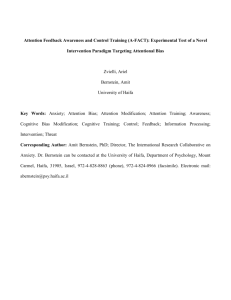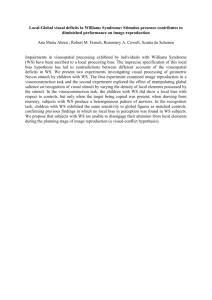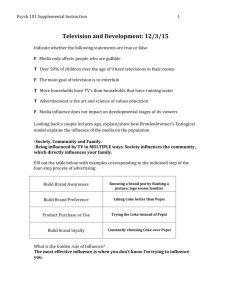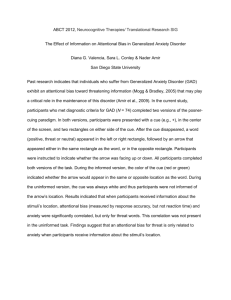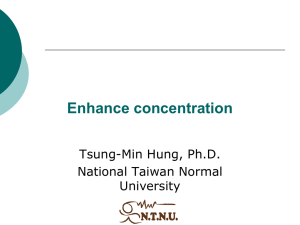Strategic and Impulsive Allocation of Attention: Behavioral and
advertisement
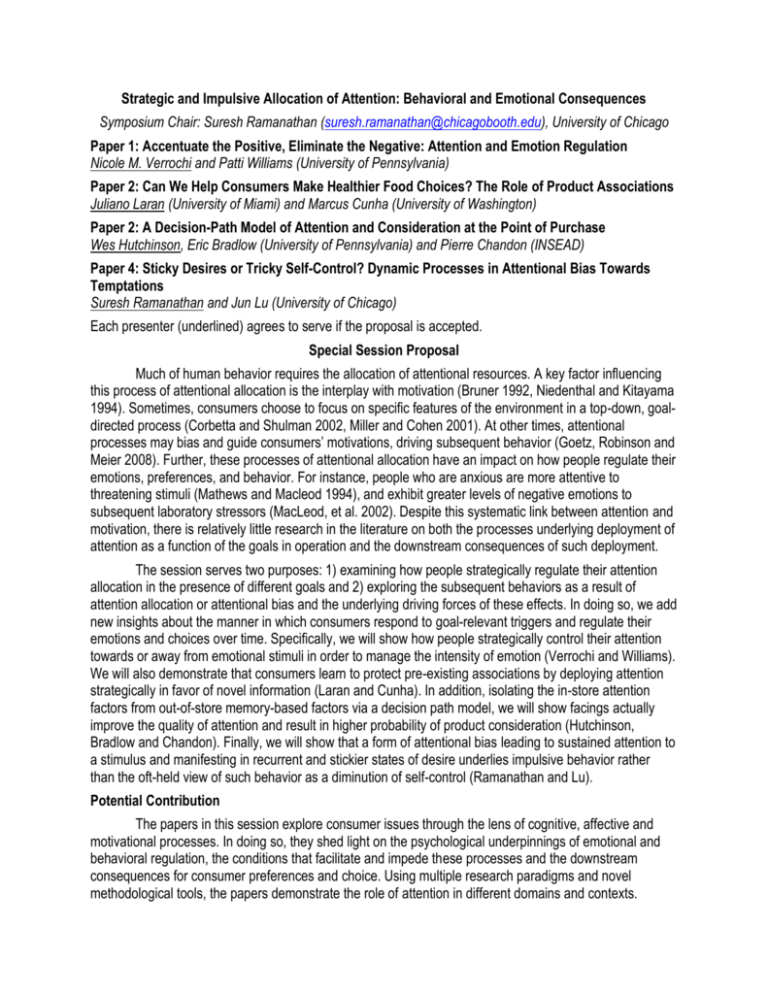
Strategic and Impulsive Allocation of Attention: Behavioral and Emotional Consequences Symposium Chair: Suresh Ramanathan (suresh.ramanathan@chicagobooth.edu), University of Chicago Paper 1: Accentuate the Positive, Eliminate the Negative: Attention and Emotion Regulation Nicole M. Verrochi and Patti Williams (University of Pennsylvania) Paper 2: Can We Help Consumers Make Healthier Food Choices? The Role of Product Associations Juliano Laran (University of Miami) and Marcus Cunha (University of Washington) Paper 2: A Decision-Path Model of Attention and Consideration at the Point of Purchase Wes Hutchinson, Eric Bradlow (University of Pennsylvania) and Pierre Chandon (INSEAD) Paper 4: Sticky Desires or Tricky Self-Control? Dynamic Processes in Attentional Bias Towards Temptations Suresh Ramanathan and Jun Lu (University of Chicago) Each presenter (underlined) agrees to serve if the proposal is accepted. Special Session Proposal Much of human behavior requires the allocation of attentional resources. A key factor influencing this process of attentional allocation is the interplay with motivation (Bruner 1992, Niedenthal and Kitayama 1994). Sometimes, consumers choose to focus on specific features of the environment in a top-down, goaldirected process (Corbetta and Shulman 2002, Miller and Cohen 2001). At other times, attentional processes may bias and guide consumers’ motivations, driving subsequent behavior (Goetz, Robinson and Meier 2008). Further, these processes of attentional allocation have an impact on how people regulate their emotions, preferences, and behavior. For instance, people who are anxious are more attentive to threatening stimuli (Mathews and Macleod 1994), and exhibit greater levels of negative emotions to subsequent laboratory stressors (MacLeod, et al. 2002). Despite this systematic link between attention and motivation, there is relatively little research in the literature on both the processes underlying deployment of attention as a function of the goals in operation and the downstream consequences of such deployment. The session serves two purposes: 1) examining how people strategically regulate their attention allocation in the presence of different goals and 2) exploring the subsequent behaviors as a result of attention allocation or attentional bias and the underlying driving forces of these effects. In doing so, we add new insights about the manner in which consumers respond to goal-relevant triggers and regulate their emotions and choices over time. Specifically, we will show how people strategically control their attention towards or away from emotional stimuli in order to manage the intensity of emotion (Verrochi and Williams). We will also demonstrate that consumers learn to protect pre-existing associations by deploying attention strategically in favor of novel information (Laran and Cunha). In addition, isolating the in-store attention factors from out-of-store memory-based factors via a decision path model, we will show facings actually improve the quality of attention and result in higher probability of product consideration (Hutchinson, Bradlow and Chandon). Finally, we will show that a form of attentional bias leading to sustained attention to a stimulus and manifesting in recurrent and stickier states of desire underlies impulsive behavior rather than the oft-held view of such behavior as a diminution of self-control (Ramanathan and Lu). Potential Contribution The papers in this session explore consumer issues through the lens of cognitive, affective and motivational processes. In doing so, they shed light on the psychological underpinnings of emotional and behavioral regulation, the conditions that facilitate and impede these processes and the downstream consequences for consumer preferences and choice. Using multiple research paradigms and novel methodological tools, the papers demonstrate the role of attention in different domains and contexts. This session presents a stream of research that has profound implications in consumer psychology. The Big Picture questions this session aims to address are the following: 1) How do consumers strategically allocate attention? Two of the papers (Verrochi and Williams; Laran and Cunha) suggest that people either avoid cues that are emotionally difficult or pay attention to cues that help protect existing associations. 2) What is the role of bottom-up processes in allocation of attention? The paper by Hutchinson, Bradlow and Chandon suggests that visually salient cues can actually shape preferences and affect the consideration set, controlling for memory-based retrieval. The paper by Ramanathan and Lu shows that the impulsive system guides sustained attention that in turn affects the amount of desire felt towards temptations. 3) What are the dynamics of these attentional processes? Using eye-tracking and continuous time measures of desire and avoidance, the Hutchinson et al. paper and the Ramanathan and Lu paper show how the dynamics of attentional processes unfold over time. Within a coherent theme, the four papers represent diverse conceptual and methodological interests and have a broad appeal to audience from marketers to policy makers. All papers are in an advanced stage of completion and feature current or recently graduated PhD students. We expect this session to be of interest to researchers in the domains of affect regulation and self-control, as well as cognitive learning. It will appeal to marketers aiming to affect preferences and to those seeking to protect existing brand associations. It will also be of interest to researchers with interest in designing public policy interventions aimed at reducing indulgence and increasing healthy behavior. PAPER 1 (Verrochi and Williams) SHORT ABSTRACT: We investigate attention deployment, whereby individuals shift attention toward or away from emotional stimuli to manage emotion intensity. We show attention shifts away from negative stimuli, but it only works for sad, but not fearful, experiences. Finally, attention shifts influence subjective emotion, supporting an attention deployment process of emotion regulation. LONG ABSTRACT: Individuals frequently manage their emotions, such as during a sad television commercial, looking at a soothing picture in a waiting room, or avoiding a plate of cookies at a party. In marketing, there is growing interest in understanding these emotion regulation processes and which strategies consumers use in various situations. Research (e.g., Gross 1998) has proposed five classes of emotion regulation strategies: situation selection, situation modification, attention deployment, cognitive change, and response modulation. To date, the bulk of research has focused on cognitive change and response modulation (Gross and Levenson 1993), while newer work has explored situation selection (e.g., Andrade and Cohen 2007). While each of these papers contributes to a deeper understanding of emotion regulation and its psychological components, certain strategies remain under-investigated. This paper investigates attention deployment, whereby individuals strategically shift their attention toward or away from emotional stimuli to manage emotional experiences. Two studies demonstrate that people use attention shifts when presented with emotional stimuli, and a third shows that these changes in attention influence the intensity of experienced emotion, supporting an attention-based emotion regulation strategy. Two studies tested whether individuals use attention shifts to regulate emotions when they encounter emotional stimuli. To examine these strategic attention shifts, a novel paradigm was created combining attention measures with emotional experiences. Attention was indexed by participants’ accuracy as they identified rapidly presented targets. These measures captured whether the individual was focusing closely on the target or diverting attention away from it. Thus, participants were asked across many iterations to indicate whether a letter “T” was presented either upside-down or right-side-up as quickly as possible (the “T task”). Intermixed with the “Ts”, participants were also exposed to a series of pictures. These pictures were from the International Affective Picture System (IAPS: Lang, Bradley and Cuthbert 2005), and reliably elicit emotional responses. The pictures appeared in the target location periodically throughout the study. Thus, if participants shift attention toward and away from emotional triggers, accuracy should change for the “Ts” which follow each emotional picture. In the first study, participants were exposed to pictures that were positive (e.g., puppies) and negative (e.g., car crashes). Results showed that participants performed worse (lower accuracy) on the T task following negatively valenced emotional stimuli (p <.001). This suggests that individuals are diverting their attention away from the target when they encounter a negative stimulus, versus focusing their attention on the target when it was positive. To test the influence of specific emotions on the efficacy of attention shifts, the second study involved a two-group design. The negative pictures were all either fearful (e.g., attacks) or sad (e.g., crying children) pictures. Research has shown differences between emotions of the same valence, such as fear and sadness; both are negative but fear is characterized by uncertainty and heuristic processing, while sadness is certain and engenders systematic processing (Tiedens and Linton 2001). In the fear condition, attention was unchanged across emotional stimuli (p > .25), but in the sad condition, performance worsened after a negative (sad) versus positive picture—as in study 1 (p <.01). This would suggest that in the sad condition, participants are strategically shifting their attention away from negative stimuli. However, for fearful stimuli, attention seems to remain focused on the target, reducing the likelihood that an individual could shift attention away from fearful stimuli. The results from studies one and two suggest that individuals naturally use attention shifts when encountering emotional stimuli, however certain negative emotions (fear) may be resistant to an attention-based emotion regulation strategy. These two studies support attention as a key moderator of emotional experience, but do not connect these shifts to emotional experience. The third study captured this effect. Participants watched an emotional video clip (sad, fearful) under attention instructions. Participants were told to either focus on the faces of the actors (directing attention toward emotional cues) or on set design (diverting attention away from emotional cues). By manipulating participants’ attention, the study assessed whether diverting attention away from emotional cues (versus directing attention toward) would reduce the intensity of emotion. Results show that within the sad condition, participants who directed their attention toward emotional cues (faces) experienced higher levels of sadness (M = 5.04) than those who diverted attention away from emotional cues (scenes: M = 3.69, p<.05). This pattern supports the hypothesized function of attention: when attention is directed onto emotional cues the intensity of emotion increases, but when attention is diverted away from these cues intensity decreases. For ratings of fear, however, the attention manipulation was non-significant (p > .20). These studies demonstrate that individuals shift their attention in response to emotional stimuli, and that changes in attention influence the experience of emotion. Additionally, these results identify specific emotions which are more or less susceptible to regulation via attention deployment—an important boundary condition. Taken together, these studies certify that attention can be used to effectively manage emotional experiences, suggesting new directions for emotion regulation and consumer research. PAPER 2 (Laran and Cunha) SHORT ABSTRACT: We propose an associative mechanism in which shared food items acquire weak association with the second food pairing and distinct food items acquire a strong association with the second pairing. Four experiments show that this mechanism robustly explains consumer choices healthy versus unhealthy food pairings. LONG ABSTRACT: It is lunch time and Mary heads to the fast food restaurant near her office. She was about to order the usual Combo # 1, featuring a chicken sandwich and fries, when she notices that the restaurant introduced a second option, Combo # 2. This option features the same chicken sandwich available in Combo # 1and mixed greens salad. Mary likes fries and salad to the same extent, so what will determine whether she chooses Combo # 1 or Combo # 2? The choice might be explained by whether consumers feel they have made enough progress on a healthy eating goal recently (Fishbach & Dhar, 2005), by the amount of self-control resources available to consumers at the time of choice (Baumeister, Bratslavsky, Muraven, & Tice, 1998; Vohs & Faber, 2007), and by the most activated goal (i.e., healthy eating or indulgence) at the time of choice (Chartrand, Huber, Shiv, & Tanner, 2008) Our research adds to the growing interest in understanding the role of presentation format on consumers’ evaluations and choices of healthy vs. unhealthy food pairings (e.g., Fishbach & Zhang, 2008; Wilcox, Vallen, Block, & Fitzsimons, 2009). We propose that a mechanism of protection of associations can change the salience of each option in the scenario described above (Cunha, Janiszewski, & Laran, 2008; Kruschke, Kappenman, & Hetrick, 2005). We will show how this protection mechanism can contribute to understanding the process via which resources depletion and goal priming may operate as drivers of self control. The Association Protection Mechanism. Consumers develop a large number of associations throughout their lifetime. For example, through repetition and co-occurrence, consumers learn that bacon and eggs, hamburger and Coke, tuna and mayonnaise go well together. Protecting these learned associations from interfering associations decreases cognitive costs and helps consumers more rapidly learn and adapt to their environment. The idea of protection of associations is grounded on attentional learning theory (Cunha et al., 2008; Cunha & Laran, 2009; Kruschke, 2001) and is predicted to occur when the cognitive system directs attention to information that can solve this potential conflict in the knowledge structure. Attention is then steered toward information that is useful in acquiring novel knowledge while still protecting prior knowledge. For instance, when Mary first learned about Combo #1, featuring chicken sandwich and fries, there was no previous association between the food items and “Combo #1”. Therefore, it is likely that both food items became associated with Combo # 1. When Mary became aware of Combo # 2, featuring chicken sandwich and salad, a conflict occurred (chicken sandwich partially defines Combo #1). Combo # 2 features a new food item (salad) that can facilitate the acquisition of new knowledge while preserving prior knowledge. Because reassessing and updating prior associations of Combo # 1 could be cognitively taxing, Mary can solve the conflict by simply shifting attention away from “chicken sandwich” and toward “salad” when presented with Combo # 2. As a result, “chicken sandwich” should become more strongly associated with Combo # 1 than with Combo # 2, whereas “salad” should become more strongly associated with Combo # 2 than “fries” are associated with Combo # 1. If Mary finds the chicken sandwich to be more desirable than the distinct items, she will judge Combo #1 to be more desirable overall. If she finds the distinct items to be more desirable than the chicken sandwich, she will judge Combo #2 to be more desirable overall. The experiments involved the sequential presentation of food pairings followed by judgments of likelihood to consume each pairing. The sequential presentation was used to influence the strength of associations between food-items and their respective pairings. Study 1 shows that these associations may determine whether food choices are healthy or unhealthy. Study 2 shows that depleting consumers of their self-control resources affects their attentional capacity. As a consequence, we observe and amplification of the basic effect reported in Study 1. Study 3 and 4 show that the effect can be replicated using actual restaurant menus with a single exposure to the menus. An important question stemming from our research is how policy makers and marketers can use our results? Policy makers can raise consumers’ awareness of their tendency to protect associations so that they can more efficiently allocate attention when making choices with implications for consumer welfare. Legislators can also enforce that marketers design product displays, in a way that directs attention to specific options first, which will drive subsequent attention and choice. PAPER 3 (Hutchinson, Bradlow and Chandon) SHORT ABSTRACT: How do consumers decide what to look at and what to consider at the point of purchase? Using an eye-tracking experiment and a decision path model, we examine whether in-store attention causes consideration (or whether people look at already-considered brands) and whether facings increase brand preferences (or simply provide another opportunity to consider the brand). LONG ABSTRACT: Consumer behavior at the point of purchase is influenced by out-of-store memorybased factors (e.g., brand awareness and brand image) and by in-store attention-based factors (e.g., position and number of facings). In today’s cluttered retail environments, creating memory-based consumer pull is not enough; marketers must also create “visual lift” for their brands—that is, incremental consideration caused by in-store visual attention. The problem is that it is currently impossible to precisely measure visual lift. Surveys can easily be conducted to compare pre-store intentions and post-store choices but they do not measure attention. They cannot therefore tell whether ineffective in-store marketing was due to a poor attention-getting ability—“unseen and hence unsold”—or to a poor visual lift—“seen yet still unsold”. Eye-tracking studies have shown that eye-movements to brands displayed on a supermarket shelf are valid measures of visual attention, are correlated with brand consideration, and are influenced by POP marketing (Chandon et al. 2009; Russo and Leclerc 1994; Van der Lans, Pieters, and Wedel 2008). However, they have not provided a method for separating the effects of attention and memory on consumer decisions. They have also not shown that attention to a brand causes consideration, rather than memory for a brand to be considered causing visual search for that brand. In this study, we show how eye-tracking data can be used to separate the effects of visual factors from memory-based factors as a determinant of brand consideration and hence to decompose a brand’s consideration into its baseline and its visual lift. To achieve this goal, we develop a parsimonious decisionpath model of visual attention and brand consideration. The model is designed for simple eye-tracking data consisting of joint observations of the number of eye fixations provided by the study (zero, one, two, three, or at least four) and the consideration decision (yes or no) for each brand and consumer. We model the P-O-P decision making process as a sequence of events that alternate between sub-decisions to consider the brand and sub-decisions to make an eye fixation on the brand (see Figure 1). The first decision is a memory-based, pre-store consideration that is made before the brand is noticed. Next, consumers decide whether or not to look at the brand. If the brand is not fixated, no new information is acquired, and the consideration decision remains unchanged. If the brand is fixated, the new eye fixation provides a new opportunity to consider the brand. We assume that consideration is irreversible; that is, having considered a brand, consumers might choose to look at it again but they do not “un-consider” it. Of course, consumers may still decide not to buy the brand even though it is included in the consideration set. The model allows us to examine, first theoretically and then empirically, the effects of looks on consideration and the effects of POP activity on each of the attention and consideration decisions. First, the model shows that the conditional probability of consideration given fixation increases with the number of fixations, regardless of any marketing effects. Second, the model predicts that there are diminishing returns in the gain from each additional look. Third, we examine various models with asymmetries in attention and consideration probabilities, which allow us to examine whether people look more at brands already considered or whether facings change the “quality” of each look. We applied this model to eye-movements and brand consideration data collected in collaboration with a leading eye-tracking company. We created a fractional factorial design which allowed us to test the effects of the number (4, 8, or 12) and location (which of four horizontal shelves and four vertical blocks) of shelf facings independently of any brand-specific effects using only 12 planograms. We recruited 384 adult shoppers and asked them to look at two categories (soap bars or pain relievers) and to make either consideration decisions while their eyes were being tracked. Each planogram includes the 11 top brands of the category and one brand unfamiliar to the participants. We obtained a total of 8,304 observations. Our key findings for the soap category are that, out of an average consideration probability of 25%, 18% comes from pre-store consideration and 7% from in-store visual lift. For pain relievers, the average consideration was 24%, the average pre-store consideration was 11%, and the average visual lift was 13%. The higher visual lift for pain reliever was partly because, in this category, people are more likely to look at unconsidered brands (76%) than at already-considered brands (66%)—hence looks are more useful. In contrast, consumers were even slightly more likely to look at soap brands that they had already considered (79%) than at brands that they had not considered (76%). We also found that facings were particularly effective at attracting attention to unconsidered brands and that this effect was robust across the two categories. Finally, we found that facings slightly improved the quality of looks. Rather than simply providing another chance to toss the coin, looks caused by facings made the coin toss more likely to lead to consideration. This was particularly true for the first looks. Facings did not change the quality of looks after the fourth one. Further analyses looked at the effect of past purchase behavior. They found that visual lift is higher for regular users than for occasional users or for non users. On the other hand, the effects of facings were strongest for occasional users. PAPER 4 (Ramanathan and Lu) SHORT ABSTRACT: Attentional engagement bias towards temptation, whether forced or resulted from priming with hedonic goal, induces higher recurrence of desire in impulsive individuals, in turn leading to more intense forms of indulgence. Yet, training impulsive individuals to engage on virtuous choice can backfire and further strengthen their desire for temptation. LONG ABSTRACT: A rich body of literature has looked at impulsive or indulgent behaviors through the lens of self-control, suggesting that such behaviors arise due to weakness of will or failures in self-control (Baumeister 2002). We propose an alternative view, suggesting a larger role for desires than previously thought. Specifically, we suggest that indulge tendency arises due to a strong attentional bias towards temptations that manifests in greater and more recurrent desires, particularly among impulsive individuls. Previous literature has identified two types of attentional bias: orientation bias that results in spontaneous attraction towards stimulus and engagement bias that results in continued engagement with the stimulus. In three studies, we show that engagement bias better predicts people’s yield to temptation and stems from people’s tendency to approach temptations rather than a diminution in their ability to avoid. Furthermore, training impulsive individual to focus on stimulus inconsistent with their chronic goal can worsen the situation as their desire for temptation surges upon subsequent encounter. Experiment 1 seeks to determine the nature of attentional biases towards temptations among impulsive vs. prudent people and whether indulgent behavior results from attentional bias. Participants first completed a scrambled sentence task that was either neutral or designed to activate the need for something sweet. They then engaged in a visual probe task (Bradley et al. 2002), in which participants were required to respond as quickly as possible to a small dot probe which was presented immediately after the display of a pair of pictures consisting one of dessert and one of healthy option. Picture pairs were presented for either 100 ms or 1250 ms on the screen after a fixation cross that appeared for 500, 750 or 1250 ms at random. These were followed by a dot probe that appeared in one of the two positions and remained on screen till the respondent’s response. Attentional bias scores were computed for each participant where positive values indicate greater vigilance for temptations. Positive values at the 100 ms exposure level indicate automatic visual orientation towards temptations, while those at the 1250 ms level indicate continued attention towards desserts even when the probe appeared in the position of the fruit. After the dot probe task, participants were given the opportunity to take cookies from a filled tray as an unrelated study. Finally, impulsivity was measured via the Consumer Impulsiveness Scale (Puri 1996) two weeks after the study. Results showed that impulsive individuals exhibited an orientation bias towards temptations. In addition, impulsive individuals who were primed with hedonic goal showed greater engagement with pictures of temptations. More importantly, those who exhibited the engagement bias took more cookies than those who exhibited orientation bias or no attentional bias, implying that engagement bias towards temptations leads to subsequent indulgent behaviors. Experiment 2 examines the psychological processes underlying such attentional biases. In particular, we were interested in the dynamics of desire and avoidance towards the temptation in an attempt to determine whether indulgence is caused by strengthened desire or weakened avoidance. We changed the design of the dot probe task such that the dot probe would appear more frequently (90% of the trails) either at the location of the dessert picture or the fruit picture, thus manipulating attention in one direction. Subsequently, we measured desire-avoidance reactions towards a tempting chocolate snack on a 2-D grid by moving a mouse cursor continuously for 60 seconds. Participants indicated whether they felt little or a lot of desire and avoidance towards the snack right at the moment on two orthogonal dimensions. Using a new technique from dynamical psychology called Recurrence Analysis, we examined the trajectories followed by the time series for desires and avoidance, specifically looking for the extent to which the trajectories visited the same region in state space over time. Results confirmed that impulsive individuals who were manipulated to attend to desserts showed higher recurrence of desires and remained longer in a state of desire but not non-impulsive individuals, suggesting only impulsive individuals kept revisiting the same hedonic goal and were trapped in that goal state for a longer period of time. This phenomenon of trapped states is described in dynamical system theory as a “fixed point attractor” wherein individuals keep returning to a given state or goal despite occasional fluctuation (Carver 2004, Vallacher and Nowak 1999). In experiment 3, we further explore how training attention engagement towards either towards temptation or healthy options can impact subsequent behavior when reward-seeking systems are activated at different time points. We followed the same procedure as in experiment 2 except that participants were additionally asked to sample a small piece of chocolate before or after the dot probe task. Sampling even a small bite of chocolate can cause activation of the reward-seeking system (Wadhwa et al. 2008). Results showed that impulsive individuals experienced higher recurrence of desire towards temptation when manipulated to attend to desserts if sampling before. More interestingly, impulsives experienced even higher recurrence of desire when they attended to healthy options first and then sampled a temptation. This data pattern suggests that reactance against goals inconsistent with their chronic goals may arise as a consequence of forced attention engagement on healthy options among impulsive individuals, hence training to focus on virtue can be a bad strategy to reinforce healthy behavior. In summary, our research demonstrates that indulgent behavior exhibited by impulsive individuals is an immediate consequence of an engagement bias towards temptation that results in greater desires rather than weaker self-control. However, strengthened desire is not only limited to an elevated level of desire, but also extends to a more frequent recurrence of desire state and a longer trap time in that state. Forcing attention away from the temptation may backfire, resulting in higher recurrence of desire and consequently greater indulgence in impulsive individuals. References: Due to space limitations, references will be made available upon request.
